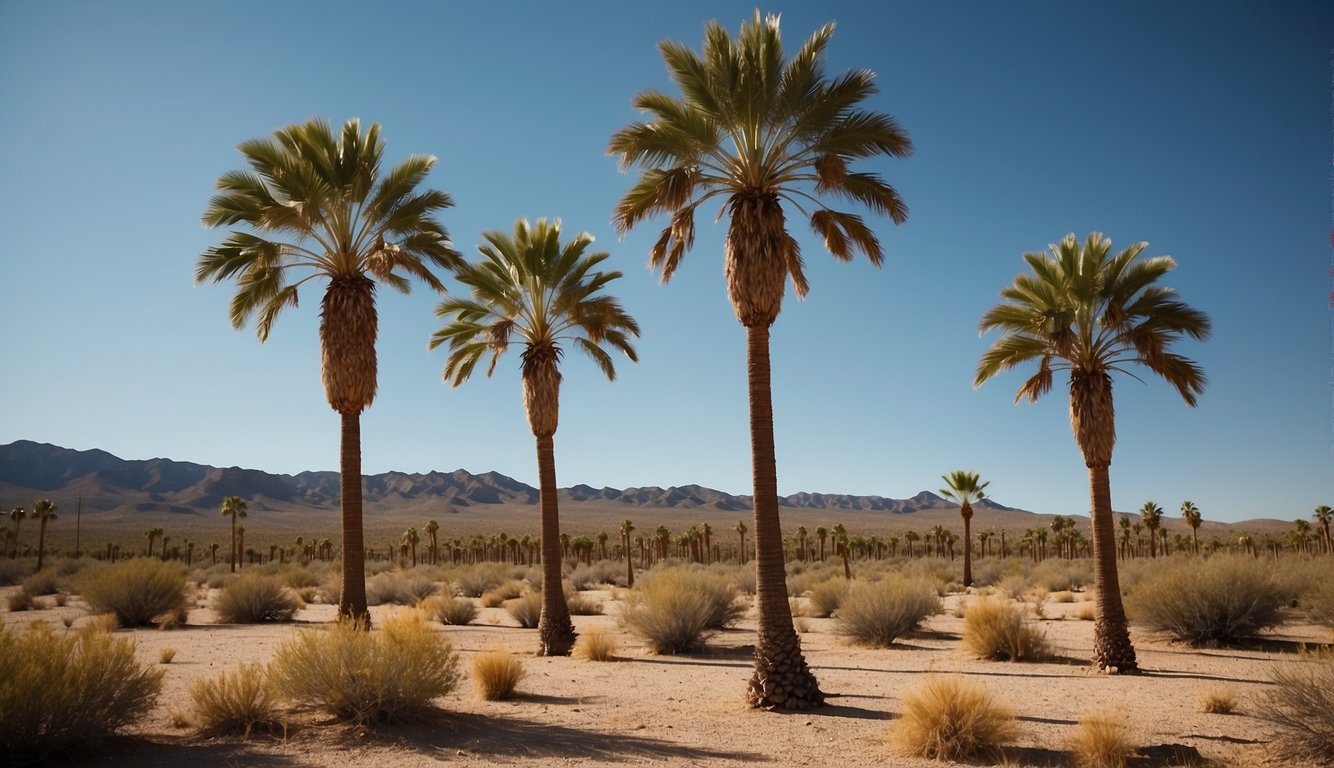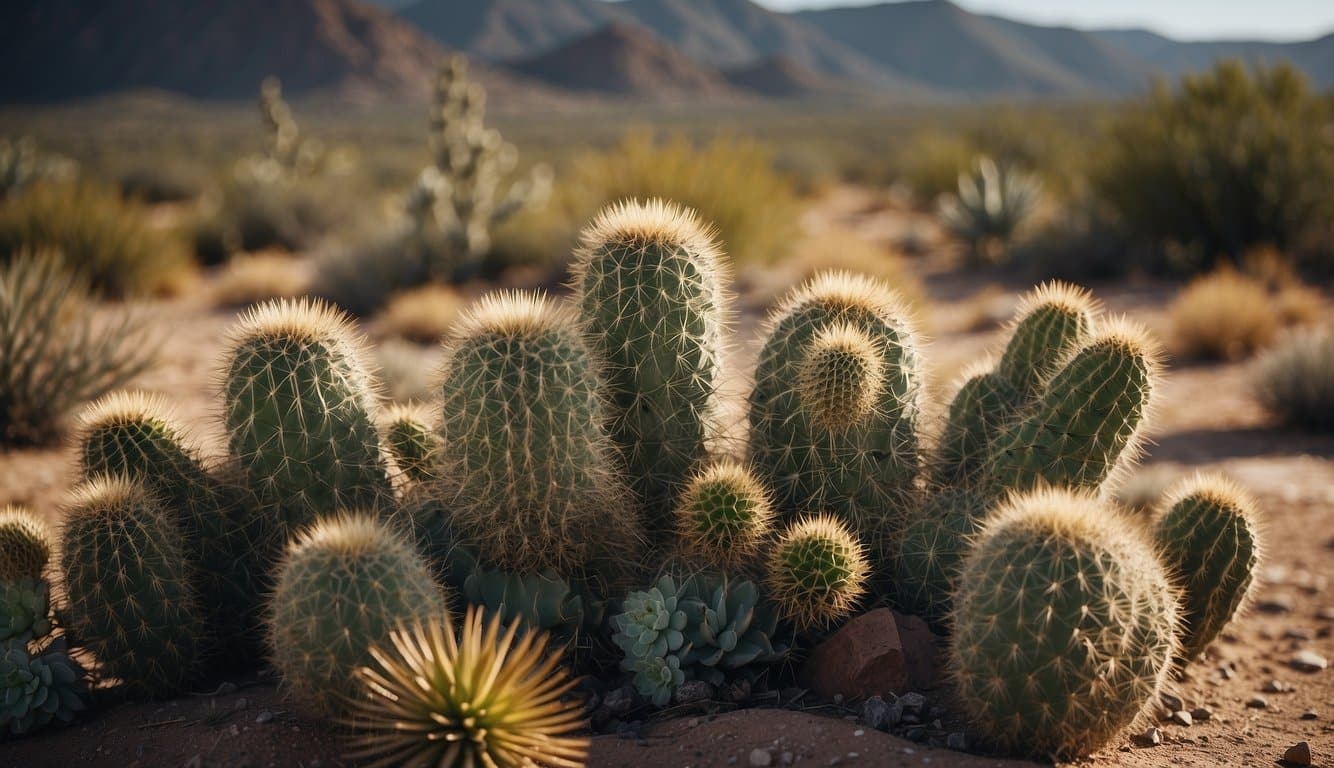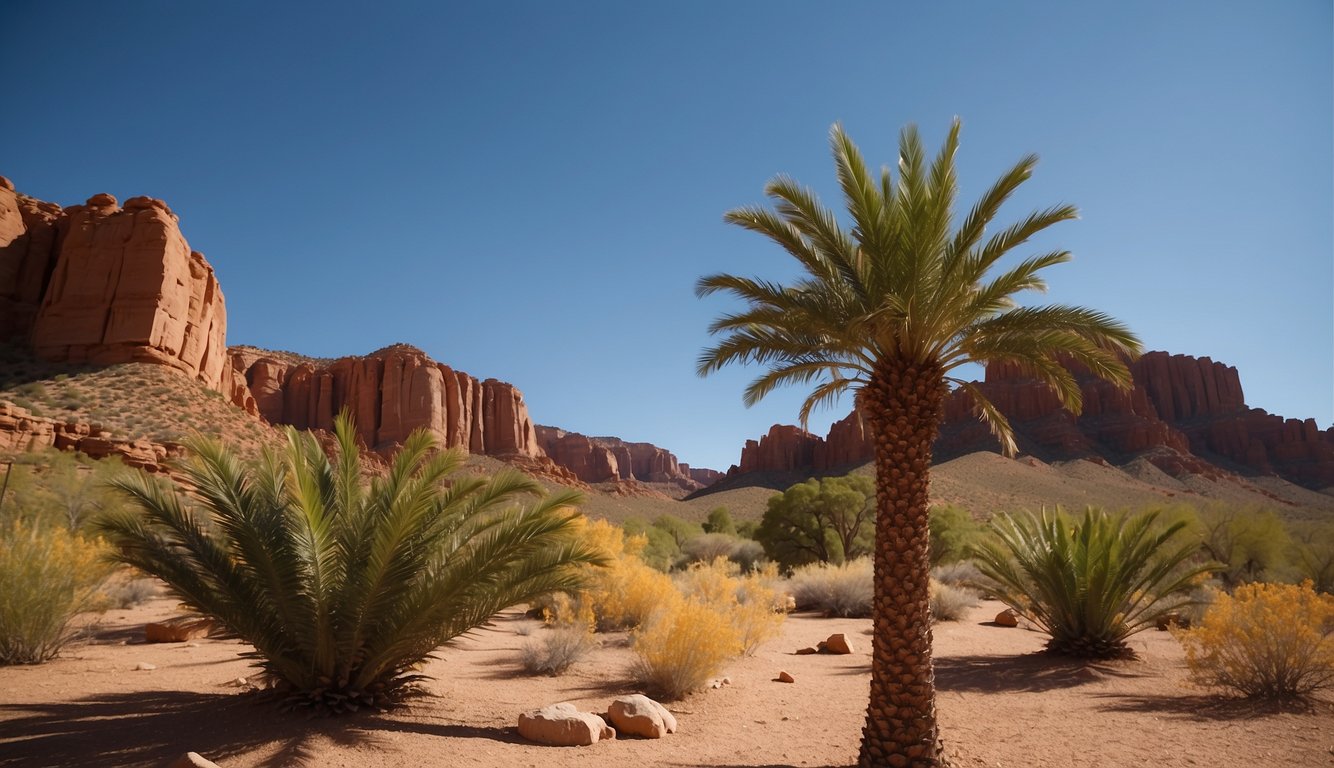New Mexico is often stereotyped as a barren desert landscape, but this Southwestern state exhibits a surprising botanical diversity, including the presence of palm trees.
Despite the region’s semi-arid climate, which may seem inhospitable to such lush vegetation, certain palm species have adapted to thrive in New Mexico’s hot summers.
The state’s varying elevation and the protective measures taken by local gardeners allow these tropical-looking trees to embellish the New Mexico scenery, especially in the southern and western parts that enjoy a warmer and drier climate.

The cultivation of palm trees in New Mexico extends beyond mere survival, as the right species selection and proper care can lead to successful and sustainable landscaping.
Cold-hardy, drought-tolerant palm varieties like the European Fan Palm and Pindo Palm have been found to manage well, benefiting from the state’s ample sunshine.
These trees, when planted in appropriate hardiness zones—areas classified by their climatic conditions—can offer a touch of the tropics to the New Mexican environment.
Key Takeaways
- Palm trees do exist in New Mexico, with certain species adapting to the local climate.
- Success with palm trees in New Mexico relies on selecting cold-hardy, drought-tolerant species.
- Appropriate landscaping practices are crucial for palm tree viability in New Mexico’s varied environments.
Palm Trees in New Mexico
In New Mexico, palm trees are a practical addition to the landscape in certain areas, specially selected for their resilience to the state’s climate.
Geographical Distribution
Palm trees in New Mexico thrive predominantly in the southern and western regions, where conditions tend to be warmer and drier compared to the rest of the state. These areas create a suitable environment for several palm species that can tolerate the semi-arid climate.
- Southern New Mexico: Increased temperatures and lower elevation make this an ideal setting for palm growth.
- Western New Mexico: The climate is similar to southern regions, supporting the presence of palm trees in landscapes.
Native Species
There are no palm species native to New Mexico. However, several non-native species have been successfully grown within the state due to their ability to withstand cooler temperatures and lower humidity levels. Some of these include:
- European Fan Palm (Chamaerops humilis): Hardy in zones 7b-11, they can withstand temperatures between 5 to 10°F.
- Pindo Palm (Butia capitata): Also suitable for zones 7b-11, Pindo palms are known for their cold tolerance.
- Sago Palm (Cycas revoluta): Although not a true palm, Sago palms can grow in zones 7b-11.
- Saw Palmetto Palm (Serenoa repens): Adaptable in zones 7a-11, with a tolerance for temps as low as 0 to 5°F.
- Windmill Palm (Trachycarpus fortunei): These palms are a popular choice for zones 7b-11 and can handle temperatures within the range of 5 to 10°F.
Climate Influence on New Mexico Flora
The diverse climates of New Mexico significantly impact the types of flora that can thrive, with particular attention to the prevalence and hardiness of palm trees within the state.
Climate Zones
New Mexico’s climate ranges across several zones, each with distinct temperature and precipitation patterns influencing plant survival. These zones are primarily determined by altitude and latitude.
- Northern New Mexico: Cooler temperatures with a higher elevation mountain climate.
- Southern New Mexico: Warmer temperatures with lower elevation desert climate.
- Hardiness Zones: The state spans USDA Zones 4 through 9, influencing which plants are suitable for growth in each area.
Palm Tree Hardiness
Palm trees, often associated with tropical environments, must adapt to New Mexico’s semi-arid and arid climates.
Hardiness Requirements for Palm Trees in New Mexico:
- European Fan Palm (Chamaerops humilis): Survives in Zones 7b-11.
- Pindo Palm (Butia capitata): Also thrives in Zones 7b-11.
- Cold Tolerance: Palm species in New Mexico must withstand temperatures as low as 5°F to 10°F in hardiness zone 8a.
Plant survival depends on selecting species that accommodate the specific climatic demands of the area. The palm trees that flourish in New Mexico’s harsh climate are a testament to this careful selection.
Landscaping with Palm Trees in New Mexico
Palm trees can thrive in New Mexico’s unique climate, particularly in the southern and western regions. Landscapers often select species suitable for the state’s USDA zones, with some palms being able to withstand Zone 7b temperatures.
Urban Landscaping
In New Mexico’s urban areas, palm trees serve both aesthetic and practical purposes.
Species like the Windmill Palm (Trachycarpus fortunei), suited to USDA Zones 7b-11, are commonly planted along city streets due to their cold hardiness and ability to add a tropical flair.
Another popular choice for urban landscapes is the European Fan Palm (Chamaerops humilis), which can endure the temperature range of 5 to 10 F corresponding to Zones 7b-11.
These palms are often seen in public spaces and are valued for their moderate size and distinctive fan-shaped leaves.
Private Gardens
Homeowners in New Mexico enjoy incorporating palm trees into their private gardens for an exotic touch.
The Pindo Palm (Butia capitata), which can tolerate Zones 7b to 11, is a favorite for its bluish-green foliage and edible fruits that mature in the summer.
In addition to its ornamental value, it provides a unique landscape feature and a natural source of food.
The Sago Palm (Cycas revoluta), despite not being a true palm but a cycad, fits well in personal gardens due to its aesthetic appeal and adaptability to Zones 7b-11. It’s noted for its rosette of dark green leaves and adds a prehistoric dimension to garden designs.
Frequently Asked Questions
Palm trees can indeed be found in New Mexico, especially within certain climate zones and cities. This section addresses some common inquiries regarding palm trees in the state.
Are palm trees naturally occurring in New Mexico?
Palm trees are not native to New Mexico, but they can be cultivated in favorable conditions, particularly in the southern and western parts of the state.
What variety of palm trees can be purchased in New Mexico?
In New Mexico, gardeners can purchase varieties such as the European Fan Palm, Pindo Palm, Sago Palm, Saw Palmetto Palm, and Windmill Palm, which are all suited to the state’s USDA hardiness zones ranging from 7a to 11.
Can Windmill palms be found in the Albuquerque region?
Yes, Windmill palms can be grown in Albuquerque, which falls in USDA Zone 7a. These palms are known for their cold hardiness, making them suitable for this area.
What are the care requirements for Needle palm trees in New Mexico?
Needle palms require well-draining soil and should be watered regularly during dry spells. They are also cold hardy and need protection from the intense sun and winds in New Mexico.
Can Sago palms survive in the climate of Las Cruces?
Sago palms can survive in Las Cruces with proper care as this city is in a warmer USDA Zone 7b-11. They need good drainage and should be protected from winter cold.
Are Palmetto palm trees suited to New Mexico’s growing conditions?
Palmetto palms can thrive in New Mexico due to their drought tolerance and ability to withstand low temperatures down to USDA Zone 7a.
However, they need adequate water during establishment and protection from extreme cold.



